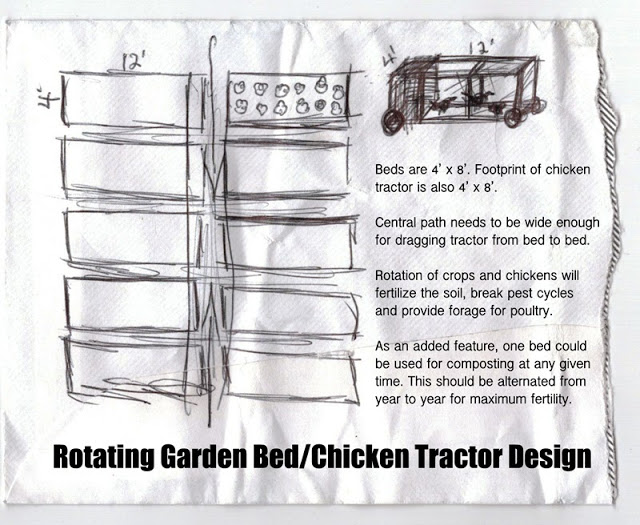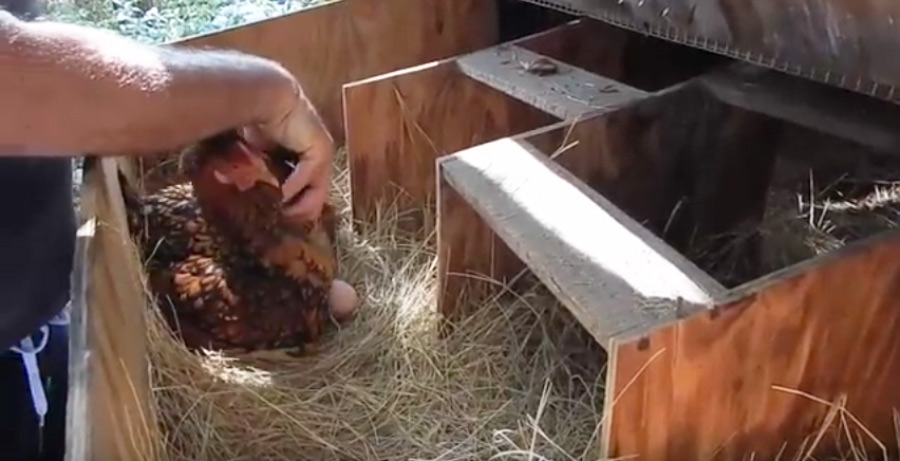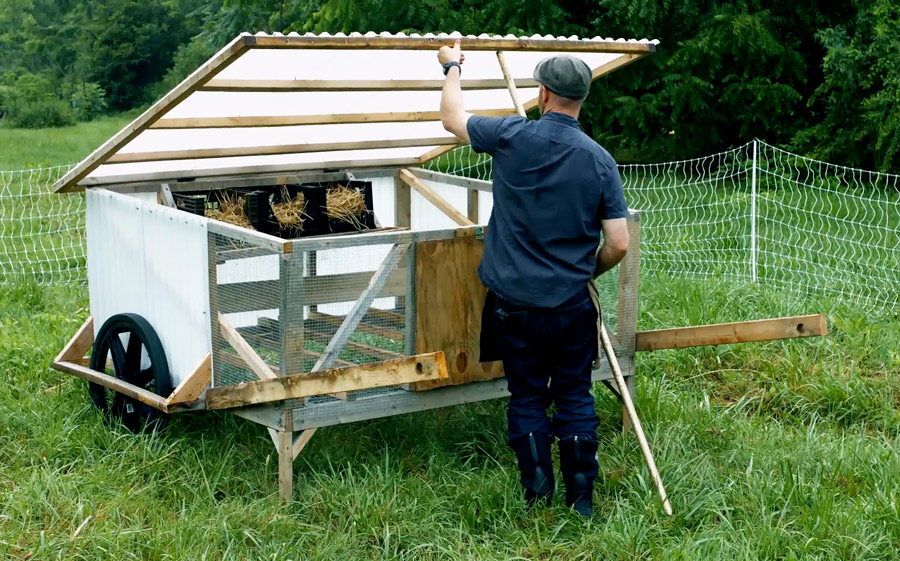
The best chicken coop design is the one that fits into your homestead and lifestyle
What is the best chicken coop design?
That question is really a can of worms.
As I shared in yesterday’s post on chickens, proper housing for our chickens was an ongoing problem. Every time we thought we had the perfect system, something would happen that would change our minds.
Our traditional chicken coop with a run needed to be closed at night or raccoons would get over the fence and kill our birds – and the chicken tractors so loved by permaculture enthusiasts and earthy backyard bird whisperers had a fatal flaw: predators could dig beneath them and behead our birds.
The search for the best chicken coop design has been an ongoing one.
Chicken Coop Design Considerations
My ideal chicken coop design would contain the following features:
- Predator proof
- Easy to access for eggs, feeding, removing birds
- Birds would could be used to improve poor soil/weed gardens
- Fresh grass/weeds available to the birds
- No need to close at night/open in the morning
That’s a tall order.
In Florida where raccoons, opossums, coyotes and dogs are everywhere, keeping your chickens safe from predators is tough. Even if you manage to keep the birds from roving four-legged bandits with a good fence, sometimes they’ll be attacked from above by hawks.
I cannot seem to create a chicken tractor that deals with these issues properly, so as much as I love the idea of keeping birds in a moveable coop I can move from spot to spot in my garden and food forest, chicken tractors that allow the chickens access to the soil (i. e. no wire on the bottom of the tractor) also allow predators to burrow up underneath their walls in the night and ravage your Rhode Island Reds.
I recently visited my friend Larry and filmed his unique chicken tractors he hasn’t had much trouble with predators and this design, though having a dog might be a help there:
Every year he raises enough meat birds for his family, plus a new round of egg-laying hens. These new tractors are pretty impressive and deal with the summer heat a lot better than some of the other ones I’ve seen.
For a mobile chicken coop design, Larry has a good thing going…
…but here’s another option.
Last year my friend Allan shared a completely different approach to chicken housing. He built a really great coop out of pallets and told me how he did it in this video:
This second chicken coop design is basically a fortress. It’s covered on all sides, making it predator proof – but it doesn’t cover points 3 and 4:
- Birds cannot be used to improve poor soil/weed gardens
- Fresh grass/weeds are not available to the birds
Point four could be mitigated by cutting and throwing grass and weeds to your chickens; however, that’s another step of labor.
So What’s The Answer?
Quite a while ago I imagined a rotating chicken tractor design (which I also cover in my book Compost Everything: The Good Guide to Extreme Composting, along with how chickens can be used to recycle lots of “waste” back into soil) that would let me use chickens to manure, till and weed my garden beds via a coop that exactly fit over each bed:

If the borders of the garden beds went deep enough into the soil that predators were unable to dig beneath them, then I believe this would be a pretty darn good way to meet all the points I’d like included in the perfect chicken coop design. I made a mistake in the graphic, however – the portion of the coop with a bottom on it should be 4 x 4′, with an 8′ run that goes over the garden bed, giving you space for plenty of birds. Alternately, the entire design should lack a floor and just be 4′ x 8′.
The chicken coop should also be locked down to the garden bed frame to keep it predator-free.
Potential problems:
1: A rotating bed design like this would only work year-round in mild climates
2: Keeping the chickens on fresh grass/weeds/spent garden crops would require more beds than pictured
3: Only a small amount of chickens could be kept.
More tweaking and thinking is obviously required.
Other Possible Chicken Coop Designs
 A design my wife would like to implement as a future chicken coop design is the Victory Garden Chicken System mentioned by Geoff Lawton in his Urban Permaculture film.
A design my wife would like to implement as a future chicken coop design is the Victory Garden Chicken System mentioned by Geoff Lawton in his Urban Permaculture film.
As you can see in the illustrations found at the first link above, it’s a dual paddock system that lets the birds run through one area, then through a second after they’ve burned that area out.
It would be easy enough to design this as a four-paddock system, too.
I recommend burying part of the fences and building them to at least 6′ to keep out the bad guys in the night, then you could likely get away with leaving the coop open overnight.
If you can’t, you might borrow from Allan Sanders’ coop design in the video and just fence over the entire top of the garden paddocks. That would really be an expensive pain, but for areas with bad predator problems it might be required.
My friend Justin Rhodes, creator of the excellent Permaculture Chickens film (You HAVE to go see his free videos here – do not pass GO, just go see them) , has his own unique approach to housing chickens he calls the “Chicksaw”:
Very clever. Though it still requires the birds to be shut in at night, it solves the burrowing predator problem and allows your flock to be moved to wherever you need some little gardening assistants.
Ultimately, the choice of housing is up to you. If you’re only keeping a few birds or if you really like keeping a schedule, a small coop you open and close morning and evening would work. If you’re like me, and you sometimes visit a friend for a few minutes then end up smoking cigars or going on a spontaneous hike through the woods in search of wild yams… well, you might need a fortress-style chicken coop.
Protecting these creatures is your primary job once you’ve taken them on – and everything in the world likes to eat chicken.
Speaking of eating chicken, tomorrow I’ll be back with a look at breeds and my experiences with both meat and laying breeds for the backyard chicken flock.



18 comments
Thank you for the great information
We have had chickens for about 18 months, and so far have been able to avoid the predators. We have 3 coops, each big enough to house 8-10 chickens. (We have 2 coops with hens + a rooster, and the 3rd coop is for extra roosters after we do a hatch (until they are big enough to butcher)). The coops have a large rope handle on them so that they can be dragged around the chicken yard (my husband moves them once every couple of weeks). The coops themselves have electric fencing around the bottom, plus the entire chicken yard is fenced in. Each day we let one cage of chickens out to roam the chicken yard. It is now bare of weeds, but I regularly throw them the weeds I pull from the garden. Right now they are also getting the broccoli plants that have finished flowering. Ideally, we’d let all of the chickens out every day, but we don’t want the roosters fighting. So, we figure alternating is better than nothing. We could have one big flock with just one rooster, but that would require a bigger coop that can’t be dragged around.
This system is working fine for us for now. Each evening the chickens go back into their cage on their own and a couple of the children will go out there to close the door, gather the eggs, and turn on the electric fence. We have forgotten the electric fence from time to time and still haven’t had any issues. We have seen an oak snake eating an egg before, but decided we are okay with that. Oak snakes are good to have around.
Our coops are wood frame with chicken wire on them, plus they each have vinyl siding on the back side to block the wind and keep them warmer in the winter (north FL). They have tin roofs. The nest boxes are at the sides and have little doors for gathering the eggs more easily. (The doors have hooks so that predators cannot open them.)
Hopefully this helps someone!
You can put wire on the bottom of the tractor that will keep out larger predators. I will get you some pictures of mine.
Thanks.
We wired ours, and like I state in the article, it kept the birds from accessing the soil. Very irritating, since tilling and weeding is what they’re great at doing. It became a choice between using the chickens as workers and losing some – or not using them as workers and keeping them safe.
why can’t you move the tractor to a safe space where you can protect the bottom. Seems to me roll it over wire, cement or wood for the evening?
That’s a good idea… if there was a way to make that easy. Maybe leave a big sheet of something near where it’s being moved around, then drag it on top for the night. Still another step, though, which is not great.
Hi. There’s a permaculture design company in VA. If you google permaculture Purcellville you might be able to see the chicken coop design they created for the 15 acre homestead there. It was a circle, like a pie, and different sections were for the chickens at different times of the year. It looked cool. Does it check all boxes or still not predator proof enough?
I’m not seeing it – let me know if you find a link.
What was your experience with the soil beneath after they’d been on a plot?
Well. I used coarse wire. So it will kill out the big stuff, like coons or dogs. But not the small stuff like weasels or mink. I have seen weasels on my place, but never had an issue. I guess they can raise heck. My cousin lost about 6 to a mink this spring.
To be honest, I didn’t use my tractor for soil conditioning. I put chickens in it because they were too young to join the rest of the birds without getting picked on and it was a handy place to put them.
My tractor was actually built for rabbits. The wire on the bottom is 2×4″ openings. So they have access to the ground. I don’t know how much scratching they would do or if the wire would inhibit that. Like I said, the chicks were only in it for awhile. I do plan to put my new chicks into it in a few weeks.
So they certainly can eat grass and vegetation through it. I’ll get some pics and you can see what you think.
One certainly does not want to use chicken wire anywhere on a tractor. It isn’t heavy duty enough. Predators will get through.
I use dog kennels that I find on Craigslist; one for my goats and one for chickens. They’re made of chain-link fence (that standard metal wire fencing you see around baseball fields). One didn’t have a top, but that was easy to remedy with some 2×4″ welded wire fence I had laying around. We have bobcats, coyotes, raccoons, and stray dogs where I live (Palm Beach County).
MY SETUP: The chicken coop has bricks around the outside perimeter to prevent digging predators. I built a roosting bar with in the back of the cage w/ 2×4’s. The back half where they roost is wrapped in hardware cloth… 1/2″ welded wire. This is better than “chicken wire” because raccoons can and will pull your chickens through cages that they can reach their grubby little opposable-thumb-having hand through. Nesting boxes are kitty litter buckets with half the lid cut off. This particular coop has a sturdy chain-link top, but I wanted rain/sun protection so I topped it w/ galvanized roof panels.
COSTS: Coop = $75, Roof = $45, Bricks = found/free, Nesting Boxes = free, Hardware Cloth = $20?, Roosting Bar = free scrap. Total ~$150 for an absolute brick shithouse of a chicken coop.
Great idea.
[…] I wrote an in-depth post on chickens and their housing earlier this year. […]
[…] are a good meat and egg source to raise and they don’t mind the pine flatwoods. I would keep them in very good housing, however, as there are many predators in Florida that will see freerange chickens as an […]
I am doing something similar to your garden bed system. I’ve got 6 garden bays, all fully enclosed (we get a lot of wildlife eating our garden produce!), and rotate the chickens through each bay for a month at a time. I’ve got photos and details here: http://green-change.com/2018/08/08/6-bay-chicken-garden-rotation-system/
[…] are a good meat and egg source to raise and they don’t mind the pine flatwoods. I would keep them in very good housing, however, as there are many predators in Florida that will see freerange chickens as an […]
[…] are a good meat and egg source to raise and they don’t mind the pine flatwoods. I would keep them in very good housing, however, as there are many predators in Florida that will see freerange chickens as an […]
Comments are closed.